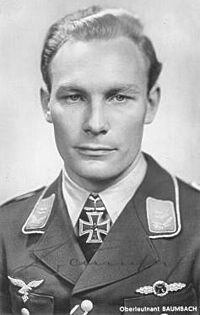Werner Baumbach facts for kids
Quick facts for kids
Werner Baumbach
|
|
|---|---|
 |
|
| Born | 27 December 1916 Cloppenburg, Lower Saxony |
| Died | 20 October 1953 (aged 36) La Plata, Argentina |
| Allegiance | |
| Service/ |
|
| Years of service | 1936–45 |
| Rank | Oberst |
| Commands held | I./KG 30, KG 200 |
| Battles/wars | World War II |
| Awards | Knight's Cross of the Iron Cross with Oak Leaves and Swords |
| Other work | Test pilot |
Werner Baumbach (born December 27, 1916 – died October 20, 1953) was a German pilot during World War II. He flew bomber planes for the German air force, known as the Luftwaffe. He was in charge of a special, secret bomber group called Kampfgeschwader 200 (KG 200). Baumbach was given a very high award, the Knight's Cross of the Iron Cross with Oak Leaves and Swords, because he helped sink many Allied ships during the war.
Contents
Werner Baumbach's Story
Becoming a Pilot
Werner Baumbach joined the Luftwaffe in 1936. This was the air force of Nazi Germany at the time. He first trained at a special air warfare school. After his training, he became a bomber pilot. He was one of the first pilots to fly the Junkers Ju 88 bomber plane. He flew many bombing missions with a group called Kampfgeschwader 30 (KG 30).
On April 19, 1940, Baumbach bombed a French warship named the Émile Bertin. He damaged the ship during this attack. For his actions, he received the Iron Cross 1st Class, which was an important military award.
Working on New Planes
In 1942, Baumbach stopped flying active missions. Instead, he started working on designing new types of bomber planes. He helped create a special system called Mistel. This system used two planes joined together, like a composite bomber.
In 1944, Baumbach was put in charge of a new group. This group was called Kampfgeschwader 200 (KG 200). This unit was responsible for all of the Luftwaffe's special missions. On November 15, 1944, he was promoted to a higher rank, Oberstleutnant. For two months, he also acted as the main leader for all bomber pilots.
Towards the end of the war, Baumbach was put in charge of the government's air squadron. This happened during the time of the Flensburg Government.
Life After the War
After World War II ended, Werner Baumbach was a prisoner of war for three years. After that, he moved to Argentina. In Argentina, he worked as a test pilot. This means he flew new or modified planes to check how they worked.
Sadly, he died in a plane crash on October 20, 1953. The accident happened near Berazategui in Argentina. He was evaluating a British Lancaster bomber for the Argentine Air Force when the crash occurred. He was buried in his hometown, Cloppenburg, Lower Saxony, Germany. A street in Cloppenburg, "Werner-Baumbach-Straße," was named after him.
In 1949, he wrote a book called Zu spät? Aufstieg und Untergang der deutschen Luftwaffe. This book was later translated into English in 1960. The English title was Broken Swastika: The Defeat of the Luftwaffe.
Awards and Honors
Werner Baumbach received many awards for his service. These included:
- Front Flying Clasp of the Luftwaffe for Bomber Pilots in Gold with Pennant "200"
- Pilot/Observer Badge in Gold with Diamonds (July 14, 1941)
- Iron Cross (1939)
- 2nd Class (September 28, 1939)
- 1st Class (May 4, 1940)
- Knight's Cross of the Iron Cross with Oak Leaves and Swords
- Knight's Cross on May 8, 1940
- 20th Oak Leaves on July 14, 1941
- 16th Swords on August 17, 1942
- The Order of Military Merit - Bulgarian

